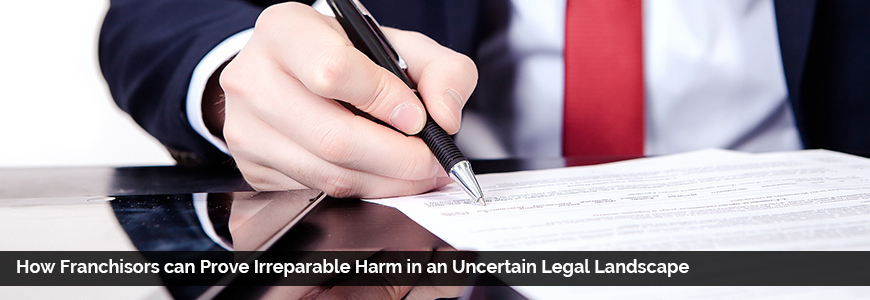How Franchisors can Prove Irreparable Harm in an Uncertain Legal Landscape
 Ever since eBay, Inc. v. MercExchange, L.L.C.in 2006 and Winter v. Nat. Resources Defense Council, Inc.in 2008, the United States circuit courts appear to be split over whether a franchisor has a presumption of irreparable harm if trademark infringement exists when seeking an injunction. In the years following these two cases, some circuits have decided to abandon the presumption altogether while some have kept it.
Ever since eBay, Inc. v. MercExchange, L.L.C.in 2006 and Winter v. Nat. Resources Defense Council, Inc.in 2008, the United States circuit courts appear to be split over whether a franchisor has a presumption of irreparable harm if trademark infringement exists when seeking an injunction. In the years following these two cases, some circuits have decided to abandon the presumption altogether while some have kept it.
Due to this circuit split and landscape of uncertainty, a franchisor should aim to be prepared to prove that such irreparable harm exists in order to obtain a preliminary or permanent injunction against a franchisee in cases of trademark infringement.
In order to do so, consider whether the judge has been involved in franchise cases before. If not or if you are not sure, take the time to explain the special relationship of franchising with a particular focus on how important the trademark is to the system as a whole. Without the protection and proper use of the trademark, the brand and system could not properly function as a franchise. Even if this explanation takes up several pages in your brief, it is important to establish with the judge that the franchising context warrants special consideration when the trademark element is being attacked by a rogue franchisee.
Once that general background is staged, the franchisor can easily segue into how the infringing franchisee is causing a loss of control of the brand. Losing control over the brand not only harms the franchisor and its reputation but also has the possibility of harming the business of nearby franchisees. Since the trademark element links the franchise system together, if the trademark message becomes muddled, or worse tarnished, then the entire system can be negatively affected.
To that end, consider whether there have been customer complaints and/or instances where consumers are confused between the franchisee’s infringing operations and other franchisees’ compliant operations. Similarly, be prepared to analyze whether franchisees or the franchisor has lost customers, decreased gross sales or had other negative economic effects caused by the infringing franchisee. These types of issues tend to show the negative domino effect of trademark infringement by a non-compliant franchisee. By showing that the infringing franchisee is patient-zero for a host of issues within the system, the court may be more convinced that irreparable harm exists and could be fixed by prohibiting the infringing franchisee from continued action.
In addition to looking for facts in the system at the whole, also consider certain facts within the franchisor’s headquarters, such as the investment, including time, money and other resources, spent on obtaining and maintaining the trademarks at issue. The higher the investment and the longer the use of the trademark by the franchisor, the better chances of showing irreparable harm. Even more helpful would be if the brand is well known across the nation or even within a certain geographical area, rather than isolated locations scattered across various states. Review the locations of all franchisees and corporate-owned locations to consider how much market share the brand has in the area of the infringing franchisee.
In essence, bring anything and everything to light about how the system has changed for the worse since the infringing franchisee has begun infringing.
Back



